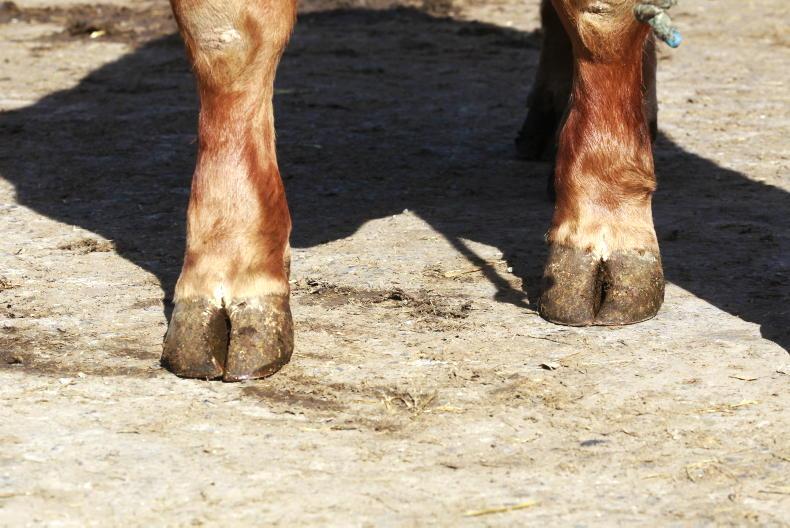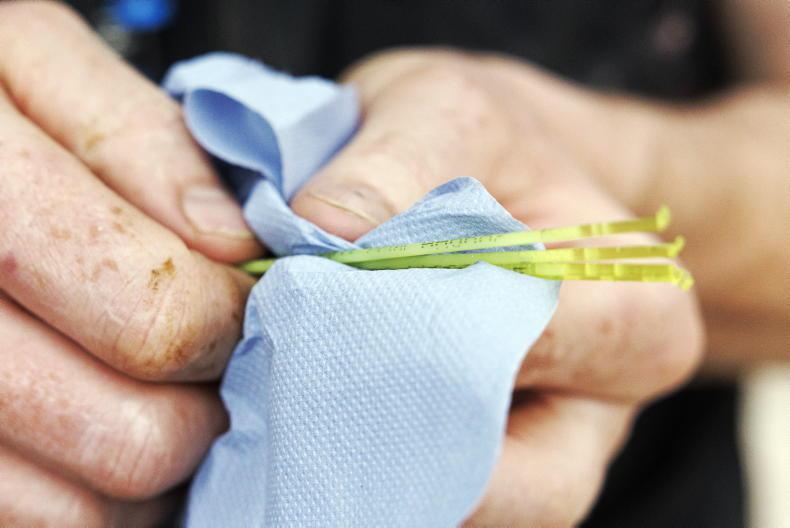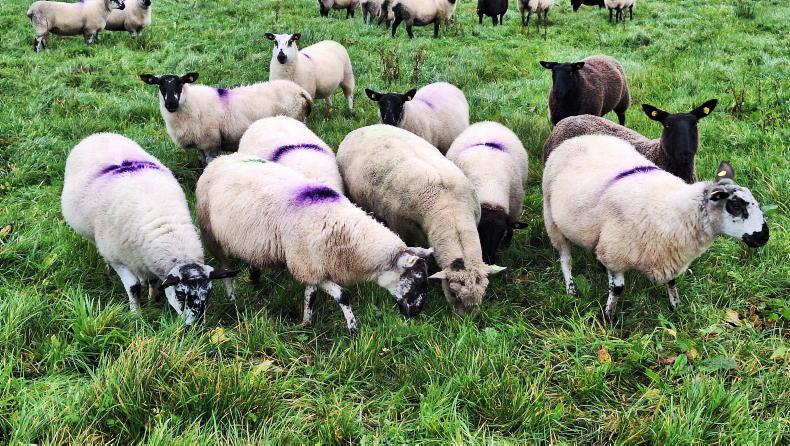Several participants on the Dairylink Ireland programme are preparing for inspections for the first time as part of the Red Tractor quality assurance dairy scheme.
These farmers supply Lakeland Dairies and the co-op wants its Northern Ireland suppliers to become Red Tractor-assured by the end of the year.
It follows the merger with LacPatrick Dairies, which brought with it contracts for the UK retail market that require Red Tractor-assured milk.
Almost all suppliers to the other dairy processors in Northern Ireland are already Red Tractor-assured.
However, farmers have become much more wary of Red Tractor audits since unannounced inspections were introduced for the scheme in April 2019.
A farmer becomes eligible for an unannounced inspection if during a routine (announced) audit they have a high number of non-conformances or have non-conformances that are deemed to pose a ‘reputational risk’ to the scheme.
Milk processors have farm liaison staff that can help suppliers become Red Tractor compliant.
The advice from processors is to be well prepared for a routine audit to avoid becoming eligible for an unannounced inspection.
This means dairy farmers should not use a routine audit to establish what needs to be sorted after the inspection to become scheme compliant.
Routine inspections take place every 18 months, although random spot checks can also apply
There is a significant amount of records that will need to be compiled and presented as evidence during an inspection. This can take considerable time, so a key piece of advice is to start audit preparations early, especially for newcomers to the scheme.
Routine inspections take place every 18 months, although random spot checks can also apply.
Red Tractor participants that are also part of the Northern Ireland Beef and Lamb Farm Quality Assurance Scheme can choose to have audits for both schemes carried out during the one visit.
Records, cleanliness and more records
Cleanliness is a key requirement of the Red Tractor dairy standard, with scheme guidance stating that the dairy and milk storage area must be “clean, tidy and free from foul odours and airborne dust”.
Walls and doors need to have a washable finish and floors need to be well drained with no cracks.
A fitted sink with a hot and cold tap, unscented soap and paper towels must be present in the dairy.
The milking parlour must be kept clean and tidy, with no accumulated dirt or dung. Parlour walls need to have paint with a washable finish up to at least 2.5m in height.
External lighting is required outside to allow milk to be collected at night-time
An inspector will ask for evidence of maintenance or service records for the plate cooler and bulk tank.
Records of liner changes and annual milking machine testing are also needed.
Parlours must be well lit by lights that are shatterproof or covered and free from dead flies and cobwebs.
External lighting is required outside to allow milk to be collected at night-time and the collection area must be concreted (or similar surface), with no potholes or puddles.
General tidiness in the farmyard is one of the first standards in scheme guidance: “Accumulated rubbish, redundant equipment or scrap kept in controlled areas separate from livestock/feed storage areas/public areas.”
Records
Other records required as part of the scheme include a farm map, manure management plan, complaints record and a written plan for emergency situations, such as power cuts, disease outbreaks and pollution incidents.
A supplier warranty (or a data sheet) for chemicals/cleaning agents used around the milking area is needed to show manufacturers’ instructions for their use and as evidence that they are non-tainting, non-toxic, etc.
Flooring needs to be clean, non-slip and well drained
Livestock housing and handling facilities must be secure, with no sharp edges. If young stock are housed on slats, an area of bedding has to be available also.
In the cow house, there needs to be at least one cubicle per cow and a loafing area of at least 120% the size of the cubicle area.
Flooring needs to be clean, non-slip and well drained.
A record of all purchased feedstuffs will be inspected.
Documented feed plans for the milking herd, dry cows and youngstock are needed or, alternatively, for the milking herd, body condition score records can be kept.
Animal health
Records of animal health are a key part of the Red Tractor standard and can take newcomers to the scheme a significant amount of time to compile. The exact format of records required are laid out in the scheme standard.
These include an animal health plan plus health and performance records, which are reviewed annually with a vet.
The health plan must include a euthanasia policy, colostrum protocol and farm biosecurity plan. The health and performance report must include records of lameness, mastitis and culling.
Red Tractor inspectors will ask for various pieces of evidence that are already legal requirements
Medicine records are required for purchases, administrations and disposals and an annual review of antibiotic use must be undertaken by a vet.
Red Tractor inspectors will ask for various pieces of evidence that are already legal requirements, such as livestock movement records and a herd register. A certificate of competence for pesticides applications, an NSTS sprayer test certificate and records of all applications are required if pesticides are used on the farm.
Read more
Lakeland wants Red Tractor milk
Getting prepared for calving in Derry
Several participants on the Dairylink Ireland programme are preparing for inspections for the first time as part of the Red Tractor quality assurance dairy scheme.
These farmers supply Lakeland Dairies and the co-op wants its Northern Ireland suppliers to become Red Tractor-assured by the end of the year.
It follows the merger with LacPatrick Dairies, which brought with it contracts for the UK retail market that require Red Tractor-assured milk.
Almost all suppliers to the other dairy processors in Northern Ireland are already Red Tractor-assured.
However, farmers have become much more wary of Red Tractor audits since unannounced inspections were introduced for the scheme in April 2019.
A farmer becomes eligible for an unannounced inspection if during a routine (announced) audit they have a high number of non-conformances or have non-conformances that are deemed to pose a ‘reputational risk’ to the scheme.
Milk processors have farm liaison staff that can help suppliers become Red Tractor compliant.
The advice from processors is to be well prepared for a routine audit to avoid becoming eligible for an unannounced inspection.
This means dairy farmers should not use a routine audit to establish what needs to be sorted after the inspection to become scheme compliant.
Routine inspections take place every 18 months, although random spot checks can also apply
There is a significant amount of records that will need to be compiled and presented as evidence during an inspection. This can take considerable time, so a key piece of advice is to start audit preparations early, especially for newcomers to the scheme.
Routine inspections take place every 18 months, although random spot checks can also apply.
Red Tractor participants that are also part of the Northern Ireland Beef and Lamb Farm Quality Assurance Scheme can choose to have audits for both schemes carried out during the one visit.
Records, cleanliness and more records
Cleanliness is a key requirement of the Red Tractor dairy standard, with scheme guidance stating that the dairy and milk storage area must be “clean, tidy and free from foul odours and airborne dust”.
Walls and doors need to have a washable finish and floors need to be well drained with no cracks.
A fitted sink with a hot and cold tap, unscented soap and paper towels must be present in the dairy.
The milking parlour must be kept clean and tidy, with no accumulated dirt or dung. Parlour walls need to have paint with a washable finish up to at least 2.5m in height.
External lighting is required outside to allow milk to be collected at night-time
An inspector will ask for evidence of maintenance or service records for the plate cooler and bulk tank.
Records of liner changes and annual milking machine testing are also needed.
Parlours must be well lit by lights that are shatterproof or covered and free from dead flies and cobwebs.
External lighting is required outside to allow milk to be collected at night-time and the collection area must be concreted (or similar surface), with no potholes or puddles.
General tidiness in the farmyard is one of the first standards in scheme guidance: “Accumulated rubbish, redundant equipment or scrap kept in controlled areas separate from livestock/feed storage areas/public areas.”
Records
Other records required as part of the scheme include a farm map, manure management plan, complaints record and a written plan for emergency situations, such as power cuts, disease outbreaks and pollution incidents.
A supplier warranty (or a data sheet) for chemicals/cleaning agents used around the milking area is needed to show manufacturers’ instructions for their use and as evidence that they are non-tainting, non-toxic, etc.
Flooring needs to be clean, non-slip and well drained
Livestock housing and handling facilities must be secure, with no sharp edges. If young stock are housed on slats, an area of bedding has to be available also.
In the cow house, there needs to be at least one cubicle per cow and a loafing area of at least 120% the size of the cubicle area.
Flooring needs to be clean, non-slip and well drained.
A record of all purchased feedstuffs will be inspected.
Documented feed plans for the milking herd, dry cows and youngstock are needed or, alternatively, for the milking herd, body condition score records can be kept.
Animal health
Records of animal health are a key part of the Red Tractor standard and can take newcomers to the scheme a significant amount of time to compile. The exact format of records required are laid out in the scheme standard.
These include an animal health plan plus health and performance records, which are reviewed annually with a vet.
The health plan must include a euthanasia policy, colostrum protocol and farm biosecurity plan. The health and performance report must include records of lameness, mastitis and culling.
Red Tractor inspectors will ask for various pieces of evidence that are already legal requirements
Medicine records are required for purchases, administrations and disposals and an annual review of antibiotic use must be undertaken by a vet.
Red Tractor inspectors will ask for various pieces of evidence that are already legal requirements, such as livestock movement records and a herd register. A certificate of competence for pesticides applications, an NSTS sprayer test certificate and records of all applications are required if pesticides are used on the farm.
Read more
Lakeland wants Red Tractor milk
Getting prepared for calving in Derry










SHARING OPTIONS